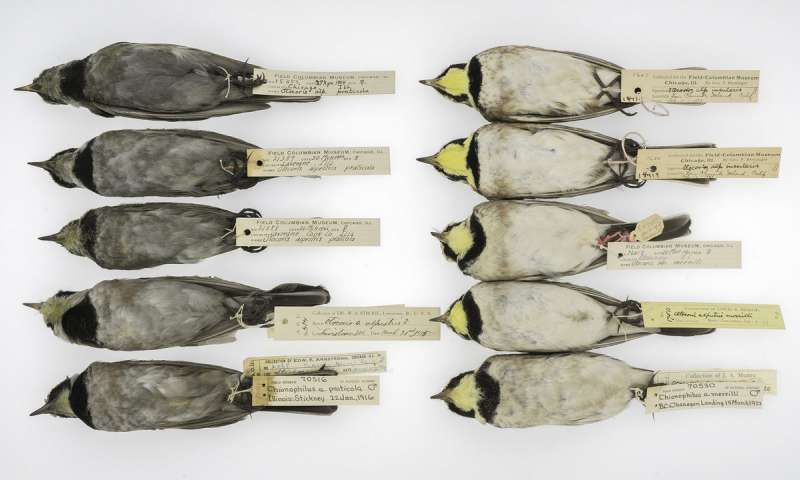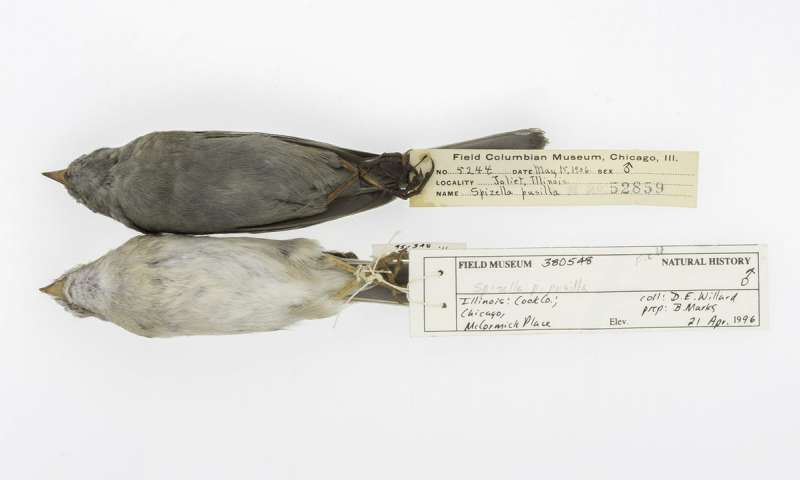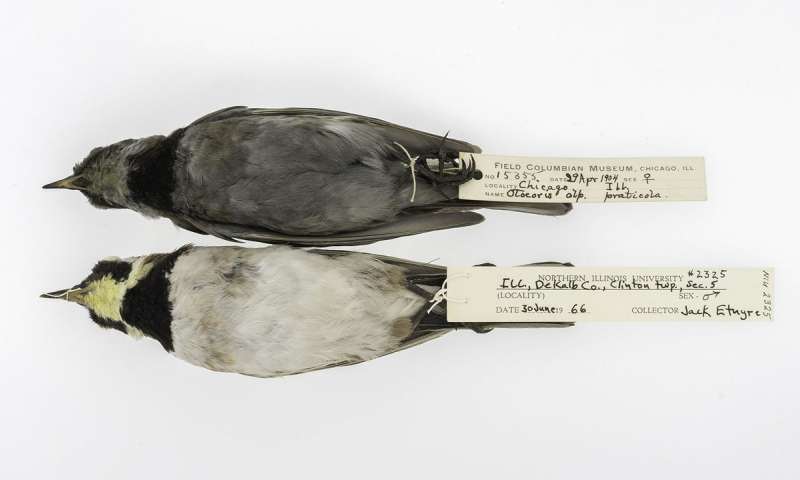We often complain about the horrid levels of pollution, but you also have to understand that things were far worse not too long ago. At the height of the steel boom a hundred years ago, the sky above Chicago and Pittsburgh was as grey and obscured as that in Beijing or New Delhi today. This history of soot and smoke can be retraced using a surprising proxy, as scientists working at The Field Museum and the University of Chicago recently demonstrated. Their work showed that levels of soot preserved on the feathers of songbirds collected over the last 135 years closely follow the levels of soot in the air over cities in the Rust Belt.

Horned Larks (Eremophila alpestris), the songbirds in question, can be frequently found across the northern hemisphere. If you have a keen eye, especially during the winter, you might be pleasantly surprised to meet the gaze of a neat yellow face, with black mask and tiny black “horns”, waving in the breeze. The bird’s cute yellow face and white belly were unrecognizable a century ago, though. As the birds dashed through the smoke-covered sky above the industrialized cities of the Rust Belt, the larks essentially acted like filters, becoming covered in soot, tail to beak.
The feather dusters
Shane DuBay and Carl Fuldner, both graduate students at The Field Museum and the University of Chicago, analyzed over a thousand birds housed in the museum’s collection, which included all five species that breed in the ‘Manufacturing Belt’. They had a hunch they could correlate the ‘dirty’ specimens with atmospheric soot levels, since ornithologists at The Field Museum had always noted that early 1900s birds were visibly darker than they should have been.
“When you touch these birds, you get traces of soot on your hands. We’d wear white gloves while handling them, and the gloves would come away stained, like when you get ink on your fingertips reading a newspaper,” says DuBay. “These birds were acting as air filters moving through the environment,” adds DuBay.
Just like you’d use a feather duster to brush off soot near a fireplace, so did the bird’s feathers cling to the deep black flaky substance as they flew about. Because they molt and grew a set of new feathers each year, the birds proved to be an ideal candidate for measuring soot deposition over the span of a year. Interestingly, older birds were always dirtier than younger ones.

To measure sootiness over the century, the pair of researchers employed a novel approach. Instead of counting soot particles or some other laborious technique, the team photographed each specimen and then measured the light reflected off of them. They had the help of a photo historian specialized on environmental photography to develop the right technique.
You can plainly see the dramatic contrast between soiled gray birds and the pristine ones in some of the images embedded in this article. But DuBay and Fuldner went a step further and plotted the amount of light bouncing off the feathers with the year the birds were collected. The higher the sootiness, the less light was reflected. They then correlated the results with historical records of urban air pollution and found there was more soot in the atmosphere than previously thought. Black carbon has a significant effect on the climate and scientists could use this new information to improve their models.
“The changes in the birds reflect efforts, first at the city level but eventually growing into a national movement, to address the smoke problem,” says Fuldner. “We are actually able to go back and see how effective certain policy approaches were.”
“We were surprised by the precision we were able to achieve,” says DuBay. “The soot on the birds closely tracks the use of coal over time. During the Great Depression, there’s a sharp drop in black carbon on the birds because coal consumption dropped—once we saw that, it clicked.” The amount of soot on the birds rebounded around World War II, when wartime manufacturing drove up coal use, and dropped off quickly after the war, around when people in the Rust Belt began heating their homes with natural gas piped in from the West rather than with coal.

Does this mean that American air is a lot cleaner because our birds are also clean? Not so fast, DuBay says. There’s far less black carbon that reaches the atmosphere over U.S. soil, that’s for sure, as evidenced by the numerous closed-off coal mines and power stations. Still, there are some cities where heavy soot chokes the air, endangering the safety of people and wildlife. But what’s more, there are now new, less-conspicuous pollutants that can jeopardize human health, despite the sky might not be clogged.
It’s interesting to note, however, how a clever use of proxies can reveal so much about our history of fossil fuel use. For instance, the study shows there was a tipping point when America moved away from burning that much coal. Right now, we’re nearing another tipping point where we’ll ditch fossil fuels for good in favor clean renewable energy. It’s a matter of ‘when’, not ‘if’.
“As a historian, one of the questions I always ask is, ‘What is the point of this research to the way we live now?’ In this case the answer quickly became clear,” says Fuldner. “Filling in a blank space in the historical record of something as large as air pollution in American cities, and being able to share that with atmospheric scientists who study the effects of black carbon on the climate, is extraordinary.”
Scientific reference: Shane G. DuBay el al., “Bird specimens track 135 years of atmospheric black carbon and environmental policy,” PNAS (2017)






